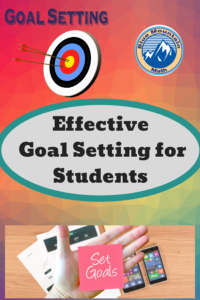Goal setting is one of the activities I use in January when students return to school after the winter break. It begins a new semester and gives us a fresh start. In the past, I used the goal setting tools provided by the administration. But last year, after my winter reading, I realized students need more than to just “set goals”. Students need strategies to help implement and follow up on goals as well. It was so successful that we are going to continue with this practice.

Students Need More than Goal Setting
In a study of Harvard MBAs, it was that 84% of them had no specific goals, 13% had goals that were not written down, and 3% had clear, written goals and plans to accomplish their goals. And it is no surprise that after 10 years the 3% who had those clear goals planned out had an income that averaged 10 times more than all the other graduates combined. This points out that just writing goals is a great start, but not enough. Not only do students need to set goals, write them out but plan how they are going to achieve those goals.
10 Reasons Why People Fail at Setting Goals:
- Not Realising the Importance of Setting Goals
- Writing Only the Long Term Goals
- Pre-Belief that It Won’t Work
- Writing Our Goals as Negative Statements
- Generic Goals
- Measuring results
- Setting irrelevant goals
- Setting unrealistic goals
- Not having
reasonable timeframe for achievement - Opinions of others
Goal Setting Tool
Goal setting is something students are familiar with and usually rely on the SMART acronym to give them a strategy to set goals. SMART stands for
S–Specific M–Measurable A-Attainable R–Realistic T–Timely. The problem with this is that many students are only given the idea and not how to implement the goals. This is like giving a non-athletic person a football uniform and sending them out to play in the big game. It does not lead to success.
“The victory of success is half won when one gains the habit of setting and achieving goals.” ~ Og Mandino
One of the first steps in any plan is to visualize. Students need to visualize themselves at graduation. They need to feel an emotional response with achieving passing grades, year-end celebrations and graduation. Even those students who are behind need to feel hopeful and make those small steps necessary to graduate. Their steps need to be different, but students (and most adults) are not able to achieve big goals without breaking them down into small manageable steps.

Most of us have made New Year’s Resolutions each year. I know I made them for over 30 years but each year I am making the same ones. Statistics say that only 8% of the resolution makers actually achieve their goals so I do not feel bad. But a few years ago that I abandoned the yearly goals and focused on making monthly goals. This is the method I present to students, a monthly goal, small steps to achieve that goal and just for fun a word to represent the month.

Student Calendar
This is the calendar I give to students. The beauty is that it doubles as an assignment calendar as well. I can post a similar calendar for classwork and projects as well as tests. At the beginning of the month, students decide on their word and goal for the month and we work to break it down into small achievable steps.
In January 2018, my word for the year was “
When February comes around, we will review those goals we made in January and begin again–with a new word, a new goal and new steps. I am still thinking about my theme for the year and I have not decided on a word for the year or word for the month yet, but then I have a few more days to the year.
Do you use a theme for the year or have a word that symbolizes your goals for the year?










Leave a Reply